New Delhi: Canadian Prime Minister Justin Trudeau rode to power in 2015 on the promise of boosting economic growth and strengthening the middle class. However, 9 years later, the Canadian economy finds itself on a shaky wicket with high inflation, increasing housing prices and a weaker per capita gross domestic product (GDP).
From the time he took over in 2015, Canada’s per capita GDP—which at one point was equivalent to or ahead of its Southern neighbour, the US, a little over a decade ago—has been comprehensively outstripped by its closest ally and neighbour.
In 2015, the difference between the per capita GDP of Canada and the US, stood at $13,378, which has since expanded to $32,766—a 144 percent widening in the gap between the two North American allies.
Data analysed by ThePrint indicates that Canada has seen a stagnant economy, with higher government debt, higher inflation and surging housing prices—albeit with lower unemployment in comparison to his predecessor’s era.
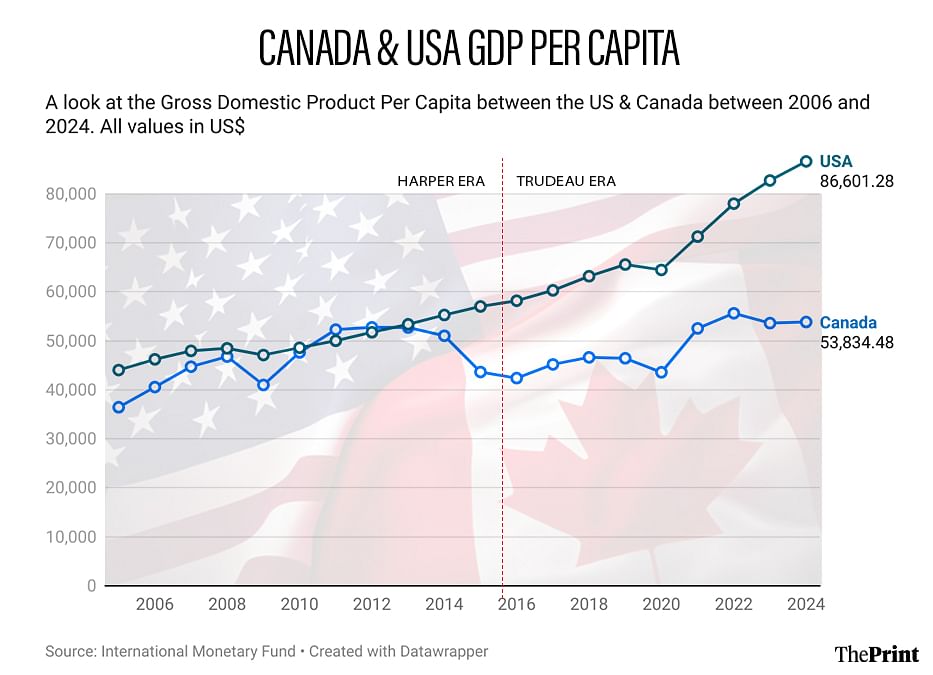
During the heydays of Stephen Harper’s administration—2011, 2012, 2013, and 2014—the Canadian per capita GDP grew in tandem with that of the US and even beat the American figures for years.
In 2011, the per capita GDP of a Canadian stood at $52,285 compared to the American’s $50,008. In 2012, as well, the Canadian per capita GDP numbers were higher than the US. The Canadian economy in 2011 grew an impressive 3.1 percent, benefitting from an average $110 per barrel price for oil and a recovery from the 2008 Global Recession, according to data published by the International Monetary Fund (IMF).
However, by 2015, in the months leading up to the federal elections in Canada, Harper’s economic legacy was left in tatters, with the fall in global oil prices leading to weak growth. That year, Canada’s GDP grew 0.6 percent while per capita GDP fell 14 percent from over $51,000 to $43,628.
In the same year, Canada’s economy struggled, Trudeau’s Liberal Party, also termed as the ‘natural governing party’ for holding power for most of the 20th century, returned to the majority in the Canadian House of Commons with aplomb.
The number of Liberal parliamentarians went from 34 in 2011 to 184 in 2015. The victory saw an end to the Conservatives dominance of Canadian politics for almost a decade.
The 9 years of Trudeau have also seen the population across Canada grow faster than it did during the Harper era. Between 2015 and 2024, the total population of Canada has grown 16 percent—from roughly 35 million people to 41 million people, according to IMF data.
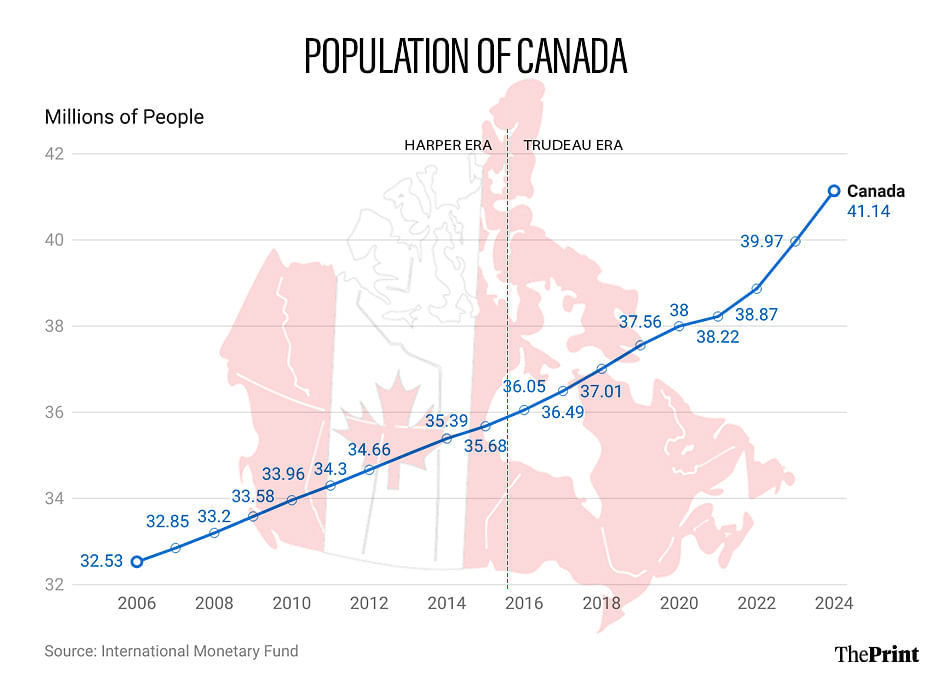
Graphic by Shruti Naithani | ThePrintBetween 2022 and 2023, the country has seen the highest growth in population in 66 years—a 3.2 percent growth. This far surpasses the 9 percent growth in the country’s population during Harper’s tenure. The bump in population comes as Trudeau opened the country to temporary low-wage foreign workers and invited a record number of students since 2022.
It is a combination of these two factors—real GDP growth only marginally higher than during Harper’s tenure and a surge in Canada’s population—which resulted in the per capita GDP remaining stagnant during Trudeau’s prime ministership.
However, in recent months, the Canadian government has taken several measures, including reducing the number of permanent resident applications approved, capping student intake, and reducing the entries of temporary workers to manage the flow of people into the country.
Trudeau’s immigration boom has affected the housing market, with the Bank of Canada’s statistics showing that since the Covid-19 pandemic, affording housing in the country has become extremely difficult.
The ratio of housing-related costs—mortgages and utilities—to the average disposable income has increased, touching 0.541 in the third quarter of 2023. The higher the number goes from zero, the more unaffordable housing becomes in Canada, according to the Bank of Canada.
Also Read: ‘Trump’s plans will hurt,’ says ex-Trudeau ally Jagmeet Singh, urges Canada PM to call them out
GDP, unemployment and government debt
Trudeau’s ascendance came in a year when Canada’s real GDP contracted for two quarters straight, including during the five consecutive months of contraction between January and May 2015. The economy, however, showed some minor growth in June and July, according to Statistics Canada.
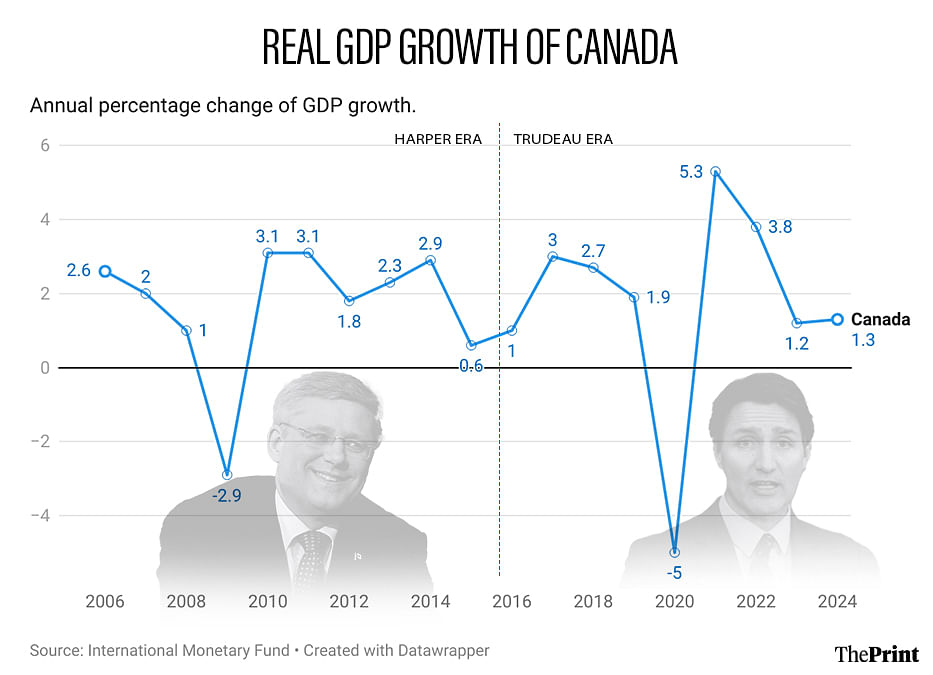
Both leaders, Harper and Trudeau, faced major global economic shocks during their tenures—the 2008 global financial crisis and the 2020 COVID-19 pandemic, respectively. Canada’s economy contracted 2.9 percent in 2009 amid the global financial crisis that hit in 2008, whereas it contracted 5 percent during the 2020 pandemic.
Even after accounting for the global financial crisis, Stephen Harper’s nine years saw an average economic growth of 1.65 percent. Canada saw the highest growth, 3.1 percent, in the consecutive years of 2010 and 2011.
Trudeau’s nine years saw a marginally higher average growth rate of 1.69 percent despite the 5 percent contraction in 2020. The economic recovery in 2021 saw the Canadian economy grow 5.3 percent.
A look at the Canadian growth under Trudeau has come hand-in-hand with a higher general government gross debt in the last nine years than the preceding era of Harper. Under both leaders, the Canadian government debt has been on an upward trajectory—from nearly 69.9 percent of its GDP in 2006 to 92 percent in 2015 at the end of the Harper era.
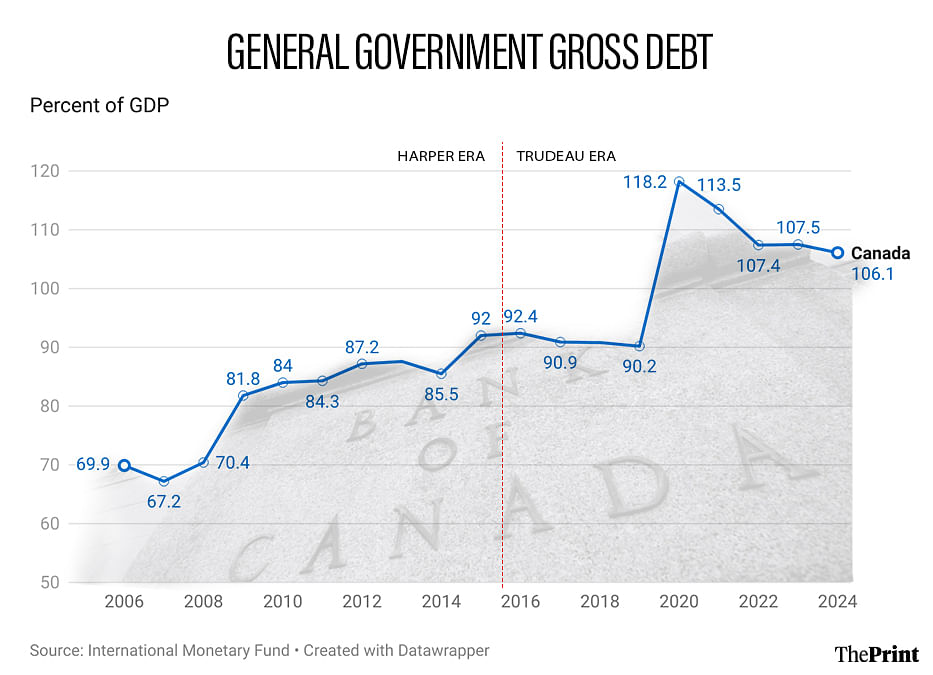
Between 2001 and 2007, the debt-to-GDP ratio consistently declined from roughly 80 percent to 67.7 percent at the end of Harper’s first year in power. However, with the onset of the global financial crisis, the debt-to-GDP ratio had touched 81.8 percent by 2009 before increasing to 92 percent at the end of the tenure of the Conservative Party leader. Throughout Harper’s nine years, Canada maintained a debt-to-GDP ratio of nearly 81 percent on average.
Under Trudeau, the average debt-to-GDP ratio has been close to 101 percent over the last nine years, peaking at 118.2 percent in 2020 during the COVID-19 pandemic before declining to its 106.1 percent forecast for 2024 by the IMF.
Between 2016 and 2019, Canada’s debt-to-GDP ratio fell by roughly two percentage points—from 92.4 percent to nearly 90.2 percent before the onset of the pandemic. Faced with financial shocks during their tenures, the two leaders dealt with them differently.
Trudeau’s popularity while on the wane ensured that the Liberal Party remained Canada’s single-largest party in 2021 despite not winning a majority in the federal elections.
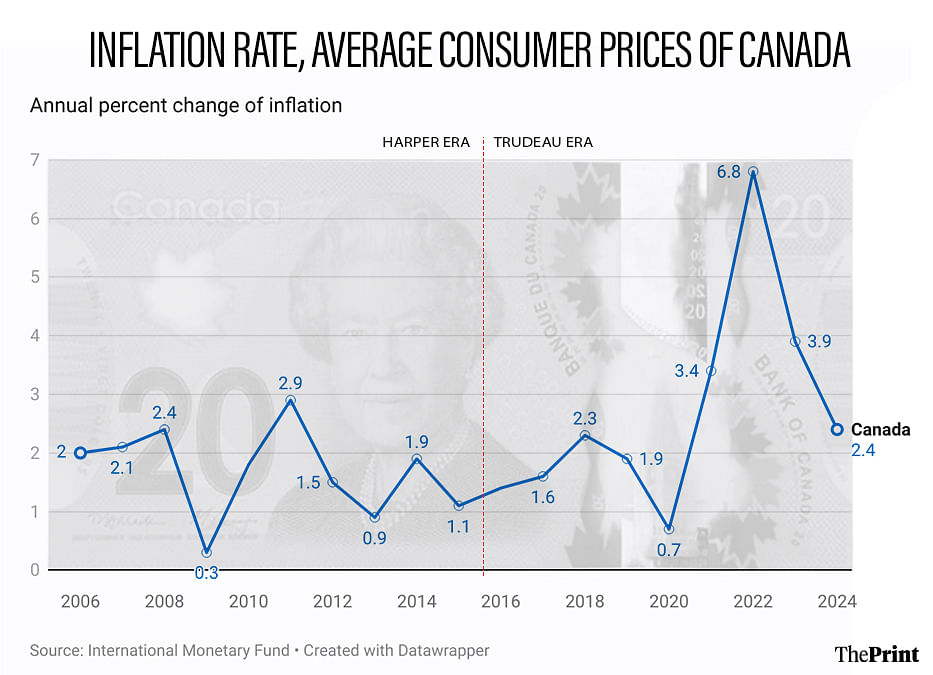
Under Trudeau, the average inflation rate in Canada has been nearly twice as high as it was during the Harper years. Between 2016 and 2024, the average inflation in Canada has consistently been at 2.7 percent—far higher than the 1.69 percent rise in consumer prices seen during Harper’s terms.
In 2022, inflation crossed the five percent mark for the first time since 1991, touching 6.8 percent during Trudeau’s tenure. The Bank of Canada, in 2023, pointed out that the rise in inflation was due to three reasons—a spike in commodity prices, a surge in global demand for goods, and impaired supply chains.
As the economy opened up post-pandemic, there was a rush for goods and services that remained unavailable in 2020 and 2021, leading to a surge in their demand, which the impact of COVID-19 on supply chains and suppliers raising prices had impaired. However, inflation has since cooled, falling to 3.9 percent in 2023 and forecast by the IMF to decrease to 2.4 percent in 2024.
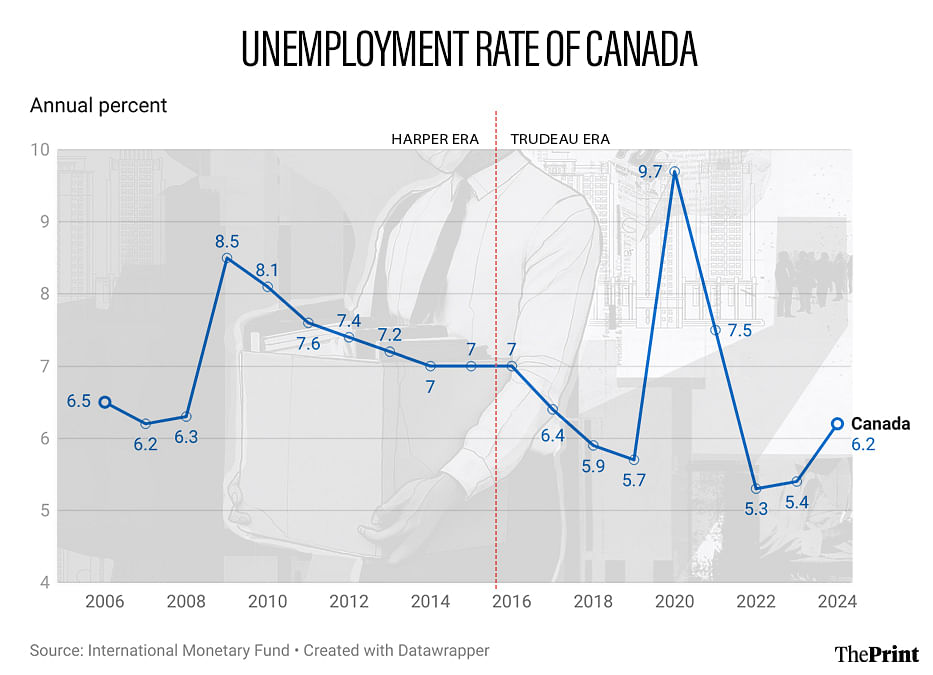
For employment, Trudeau’s nine years have been better than Harper’s. Between 2006 and 2015, Canada’s average annual unemployment rate under Harper stood at 7.1 percent. Between 2016 and 2024, the average unemployment rate under Trudeau was 6.56 percent. Between 2016 and 2019, the unemployment rate fell from 7 percent to 5.7 percent—the lowest since 2007, when it stood at 6.2 percent.
This is an updated version of the report
(Edited by Madhurita Goswami)






